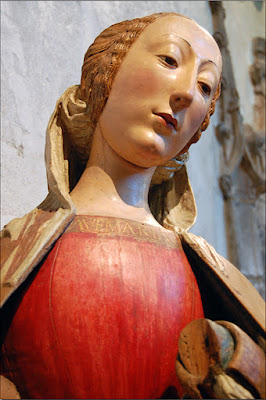 |
| Detail of Kneeling Virgin by Paolo Aquilano |
As you can imagine, after seeing the recently restored Madonna di Pietranico at the Italian American Museum I was very excited with the prospect of viewing another devotional statue from the Abruzzo. So I packed my camera and headed to The Cloisters.
 |
| Detail of Kneeling Virgin by Paolo Aquilano |
 |
| Kneeling Virgin by Paolo Aquilano |
It has also been suggested that the Kneeling Virgin's crèche may have influenced the Fontecchio presepio (Museo Nazionale Abruzzese), loosely attributed to the prestigious painter-sculptor Saturnino Gatti (L'Aquila 1463–1518 L'Aquila). Gatti is generally considered to be one of the finest Renaissance sculptors from the Abruzzo. Also a painter, Gatti's wonderful painting, The Translation of the Holy House of Loreto (ca. 1510), can be seen at Metropolitan Museum of Art.
 |
| The Translation of the Holy House of Loreto by Saturnino Gatti |
 |
| Blessing Bishop (Saint Nicholas of Bari) |
 |
| Relief from the Pulpit with the Symbol of Saint Luke |
 |
| Liturgical Comb |
If you haven't done so already, time is running out to see La Madonna di Pietranico at the Italian American Museum. The exhibit ends on June 2, 2011. Afterward the statue will be returned to the Chiesa di San Michele e Santa Giusta in Pietranico, Abruzzo.
 |
| La Madonna di Pietranico |
• Three Madonnas in Search of an Author by Carmen Gómez-Moreno, The Metropolitan Museum of Art Bulletin, June 1967 [I was amused at the title's allusion to Luigi Pirandello's Six Characters in Search of an Author.]
• Values and Symbols Dreamed in Clay by Lucia Arbace, La Madonna di Pietranico, Edizioni ZiP, 2011
Amended December 10, 2021









